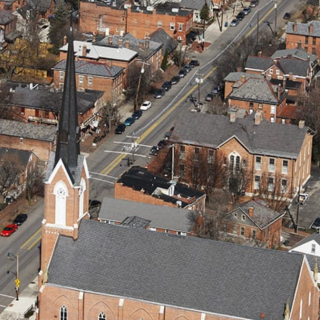Advertisement
A luxury apartment offering beautiful views of 70 West is framed by two massive water tanks. Just a short stroll away from fine dining at Bob Evans – but be careful, because there’s no crosswalk.
And don’t forget the amenities and convenience of two nearby gas stations.
Luxury apartments are sprouting up in the damnedest of places around town. Everywhere you look developers are building complexes where a cavernous 400-sq-ft pad goes for a cool $1,300-a-month and a 775-sq-ft two bedroom for an affordable $2,400/month.
Out west on the Columbus-Hilliard border it gets no weirder than the complex being built on Fisher Road. Many of the apartments will be mere feet from two city water tanks. It will be called Austin Place, built and managed by the locally-owned Donald R. Kenney & Company Realty.
Right next to Austin Place are the luxury apartments of Andover Park, where you have easy access to the sweet sounds of 70 West as well as your next door neighbor’s life considering many residents have complained online how thin (and cheap) the walls are.
The housing situation in Columbus is growing more absurd by the day. Expensive “luxury apartments” are going up everywhere for the select few, but everyone is affected.
This need to make fast and easy money off the luxury apartment boom has boosted rents across the region. The average cost of rent in Central Ohio is up four percent each of the last two years, according to national real estate firm Marcus & Millichap.
The spiking cost for housing is pushing many to the edge. The US Department of Housing and Urban Development recently reported the number of those without shelter in Franklin County is up 6.4 percent this year, nearing 2,000.
Earlier this year the National Low Income Housing Coalition reported the state’s “housing wage” increased to $15.25 an hour to afford a basic two-bedroom apartment. The problem is the average Ohio renter earns $13.32 an hour, states the coalition.
Nevertheless, local luxury apartment developers, many backed by national investors, continue to build $1,500 a month apartments for people who don’t exist. Simply put, there are only so many well-off millennials around town.
Equally painful to rising rents is how our city’s Department of Development has caved to the luxury apartment developers’ every desire. Some developers earning the city’s 10-year real estate tax abatement, for instance, which is costing Columbus Public Schools hundreds-of-thousands of dollars in much needed funds.
You only have to look out the back patio of your future Austin Place apartment, where you can almost touch a city water tank, to see how these developers have their way with the Department of Development, which had to approve of Donald R. Kenney and Company Realty’s plan to build so close to the water towers.
Donald R. Kenney is also part owner of Preferred Living which several years ago purchased the Courtyard Estates, a 55-and-older trailer park near Graceland Shopping Center. Preferred Living recently revealed plans to build luxury apartments on the site and you know how that’s going to go for the seniors who live there (bon voyage!).
Thomas Fortin of the Thomas Fortin and Company is one local developer who doesn’t have the Department of Development on a short leash. You may recall how he tried to save the Grant Oak apartment buildings and their affordability for the college students and working-class who live there. Grant Oak is owned by the Columbus Metropolitan Library and right next to the Main Library downtown.
But the library rebuffed his plan and went with the Pizutti Companies’ idea to build a mixed-use luxury complex. The Pizutti Companies must have our Department of Development and other city entities deep in their pocket because Fortin offered twice as much as Pizutti did to purchase the property. Thus, our local libraries, which could always use the money, shorted themselves roughly $1.75 million.
The Mid Ohio Regional Planning Commission (MORPC) is projecting one million new residents by 2050. Even so, Fortin believes while there is demand for luxury apartments, supply may soon become far greater than demand, especially in the central city and downtown.
“The apartment developers are cannibalizing each other. In other words, they are building very similar apartments. And the price points for these apartments are also very similar. The one-bedroom might be $1,100 a month and the two-bedrooms might be $1,500 a month,” he says. “There’s an overabundance of such one-bedroom and two-bedroom apartments. And we continue to add to the supply and the supply is exceeding the demand in that price point.”
Yet national investors and lenders keep funding local developers to build, continues Fortin. Enticed by the 10-year tax abatement offered by the city and low interest rates, he adds.
But interest rates were raised four times in 2018.
“If the 10-year tax abatements go away, or when the tax abatement ends after 10 years, and interest rates continue to click up, that could cause a repeat of what happened in 2007, 2008 and 2009,” he says. “The net operating income from those properties will not be able to afford to pay the taxes and new interest rates of tomorrow. They will have to raise rents.”
On an all-ready pricey apartment where, if you stretch out far enough, you can touch a five-story water tank, but the exit to 70 West to get to your second or third job is just around the corner.



